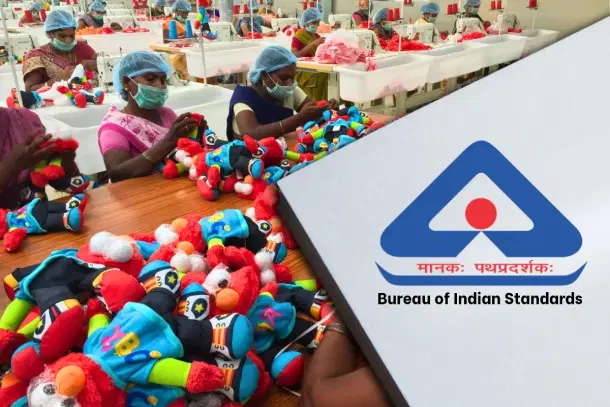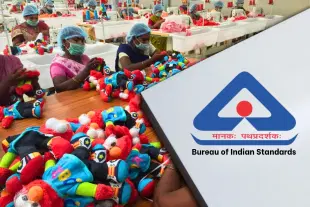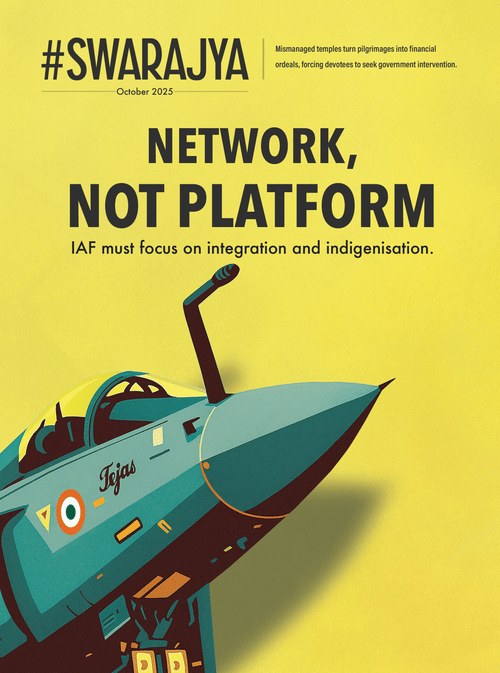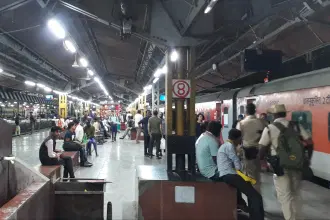Economy
500 Scientists, 769 Products: How India's Quality Push Risks Becoming A Regulatory Roadblock
Swarajya Staff
Aug 30, 2025, 11:29 AM | Updated Aug 31, 2025, 11:26 AM IST
Save & read from anywhere!
Bookmark stories for easy access on any device or the Swarajya app.


In India, quality has long been a concern when compared with international product standards. The domestic market was traditionally driven by affordability, with priority given to low costs over durability or performance. Quality was treated as secondary in many products.
In recent years, however, the government has widened the scope of mandatory QCOs to cover critical sectors such as steel, polymers, electronics, and toys.
The numbers tell the story of this dramatic expansion. From just 14 QCOs covering 106 products up to 2014, India now has over 187 QCOs covering more than 769 products.
But there is a fundamental problem with this quality revolution. India may have bitten off more than it can institutionally chew.
The Ambitious Regulatory Overhaul
The BIS Act of October 2017 made it easier to notify products, systems, and services under mandatory standards, and the government seized this opportunity aggressively.
QCOs now cover diverse sectors cover diverse sectors that touch every aspect of Indian life. These include door handles, ball bearings, steel cookware, acetic acid (Department of Chemicals and Petrochemicals), textiles such as bedsheets and sanitary napkins (Ministry of Textiles), electrical appliances (Ministry of Electronics and IT), and even reverse osmosis water treatment systems (Ministry of Environment).
Historically, India's quality control framework was administered by the Bureau of Indian Standards (BIS). Its standards were mostly voluntary rather than legally binding.
Manufacturers adopted them selectively for reasons such as consumer confidence, market access, or internal quality goals, much like Energy Star certification for appliances and ISO 9001 standards for quality management.
QCOs changed this fundamentally. Unlike voluntary guidelines, QCOs carry legal force.
Once a QCO is issued, all companies, whether Indian or foreign, large or small, must follow the same rules to sell their products in India. This means producers must prove that their products meet the required standards through a process of testing, inspection, certification, and auditing.
The expansion was strategic, closely linked to the government's self-reliant India initiative.
QCOs were designed to regulate low-quality imports and encourage domestic manufacturing.
In the footwear sector, they aimed to stop cheap, substandard leather products. In steel, there were multiple cases of sheets or aluminium products being imported that were manufactured by melting scrap metal, often without proper homogenisation techniques.
The Resource Reality: 500 Scientists, Global Oversight
Here is where ambition collides with arithmetic. India tasked just 500 scientists in BIS's scientific cadre with inspecting and overseeing testing for all 769 products (a number that continues to grow) covered by QCOs, for both domestic producers and every foreign manufacturer seeking to enter the Indian market.
Only the Bureau of Indian Standards is authorised to certify that suppliers, both foreign and domestic, comply with prescribed standards. This gives BIS a central role in inspecting facilities and approvals, but the institutional capacity has not grown at the same pace as the regulatory expansion.
The process differs dramatically for domestic and foreign producers, revealing the scale of the challenge.
For Indian producers, the application process is online, with approvals generally taking one to two months if documentation is complete.
For foreign producers, certification falls under the Foreign Manufacturers Certification Scheme (FMCS), which is largely offline and considerably time-consuming. Foreign applicants must appoint an Indian authorised representative and complete an initial application involving 15 to 16 annexures, running to a minimum of 70 to 80 pages in most cases.
Once submitted, the application goes to the relevant BIS department for scrutiny. In practice, this review process is rarely completed in one step, as files are returned with comments for applicants to resubmit missing details. This back-and-forth stretches the timeline, sometimes for months.
Following documentation approval comes the nomination process for an inspector to conduct an on-site audit abroad. The inspection date must be mutually agreed upon by the factory and assigned auditor. Manufacturers pay inspection fees ranging between USD 3,800 and 5,400.
For the visit, auditors get two days for a single product line, with an extra day for each additional product under review. During the visit, the auditor evaluates the factory's processes, quality control systems, and product conformity. Samples are collected and sent to BIS or BIS-approved laboratories for independent testing, with results treated as confidential and shared only with BIS.
The official timeline is six to eight months. The reality is that many applications remain stuck at different stages, some even for more than a year.
When Institutional Capacity Hits Breaking Point
The rapid expansion of QCOs created a surge in demand for inspections, laboratory testing, and certification that the system simply cannot handle efficiently.
Delays start from the initial documentation process. BIS officials report that most applications are incomplete or miss critical points at initial submission, forcing repeated exchanges and stretching the process.
The staffing challenge runs deeper than numbers alone. According to industry sources, international inspections were previously conducted only by senior experts with experience overseeing more than 200 audits. But as QCOs expanded and demand increased, younger scientists with less on-ground experience are now being sent for these visits.
"While this move has helped meet the load, it has also put heavy responsibilities on relatively new officials, adding pressure to prepare and complete complex audits," notes an industry source.
Logistical challenges compound the delays. Inspection visits to countries such as the United States and Denmark have faced delays due to visa issues requiring resolution through bilateral diplomatic channels.
Further, due to sudden surges with limited auditors, in East Asian countries such as Taiwan, Vietnam, Indonesia, and Malaysia, language barriers become practical obstacles that slow both factory audits and compliance processes.
The Geopolitical Wild Card
Perhaps most concerning, these institutional gaps create room for voluntary discretion that weakens transparency.
Larger geopolitical issues and diplomatic arrangements appear to influence how inspections are carried out, creating uneven outcomes across countries.
"In practice, this means that one trading partner may face prolonged certification delays at various stages of the inspection process due to strained relations, while another may benefit from smoother clearances supported by preferential arrangements," an industry expert explains.
Such discretion weakens the credibility and neutrality of QCO implementation.
"What should be a technical process of quality assurance has also been influenced by geopolitical considerations. Both importers, as well as the institution, are caught in a difficult position. Importers face delays and uncertainty, while officials have to face diplomatic complexities that lie beyond their mandate and control," he adds.
The Laboratory Testing Bottleneck
Beyond inspections lies another critical chokepoint: testing capacity. According to the BIS website, India currently has 10 BIS laboratories across the country, plus several hundred laboratories recognized and empanelled by BIS for testing purposes.
But when examining specific regulations, the capacity constraints become stark. Take the Machinery and Electrical Equipment Safety (Omnibus Technical Regulation) Order, 2024, issued by the Ministry of Heavy Industries and implemented by BIS.
This regulation covers a wide range of machinery and electrical equipment such as pumps, compressors, centrifuges, cranes, rotary electrical machines, transformers, and switchgear.
Both domestic and foreign manufacturers must obtain BIS certification under Scheme X, either as a BIS licence or Certificate of Conformity (CoC).
However, according to industry sources, "The infrastructure to handle testing for these categories remains only around seven laboratories, due to which applications are currently experiencing waiting times of three months or more. The required capacity needs to be at least twice the current level to ensure a smooth testing process."
The SME Stranglehold
Since BIS certification is mandatory, any delay in inspections or shortages in BIS capacity can effectively block imports. Until certification is granted, no imports are allowed.
"This creates severe challenges for India's small and medium-sized enterprises that depend on imported raw materials. During the waiting period, QCO restrictions prevent imports, leaving many industries without critical inputs," officials at India SME Forum tell Swarajya.
The problem intensifies when QCOs cover products for which there are no comparable domestic alternatives of similar quality and capacity. In the steel sector, the BIS licence requirement for foreign suppliers has already reduced choices available to steel users, preventing them from sourcing competitively from the best and cheapest suppliers.
A fastener importer with over 14 years in the business illustrates the real-world impact. His firm imported around 50 tonnes of material per month (two containers). However, following the introduction of quality control orders, their imports first faced a sudden stop for two months since there were no licensed suppliers available.
The company then placed an order for 40 tonnes with a domestic licensed producer, less than their monthly demand, in April 2025. However, the order remains unfulfilled even by August.
"QCOs appear to favour a handful of domestic steel producers at the expense of a much larger group of user industries, especially SMEs like ours," he says.
The consequences extend beyond domestic supply issues. While firms serving only the domestic market might manage limited competition, export-oriented firms face severe disadvantages.
"With higher costs and limited raw material access due to QCOs, Indian exporters risk losing contracts and market share abroad. International markets are highly competitive, and even a five percent price difference can shift buyer preferences," a professor specialised in international trade tells Swarajya.
The Broader Industrial Implications
The mismatch between regulatory ambitions and institutional capacity creates second-order effects that could undermine India's manufacturing goals.
Many SMEs required to scale up within India may instead turn to opportunities in other countries where doing business is easier. These MSMEs need strong support to grow domestically, but in the absence of timely facilitation, they may end up scaling their operations abroad.
This highlights the critical nature of strengthening institutional capacity while building bilateral and multilateral arrangements to recognise equivalent standards, making compliance easier.
Unlike tariffs or quotas, which are explicit trade barriers, QCOs function as absolute barriers when certification is withheld. Products cannot enter the market at all without BIS approval, making timely certification essential.
The Strategic Imperative: Matching Ambition with Capacity
The solution is not abandoning quality standards. India's reputation concerns were legitimate. The challenge is carefully determining where QCOs are necessary and where they are not, while building the institutional capacity to handle the regulatory load.
"For example, applying QCOs to viscose staple fibre, a key raw material in textiles, already has reliable suppliers and established quality standards, where the market is capable of deciding. On the other hand, industries such as toys, where material safety and chemical quality affect consumer health, are exactly where strict quality controls are necessary," the professor explains.
To prevent QCOs from turning into hidden trade barriers, India must strike a balance between strong regulation and ensuring that industries have the capacity and support to comply.
The promise of QCOs, improving product quality, protecting consumers, and building trust in Indian goods while supporting manufacturing goals remains valid.
But with 500 scientists handling global oversight of 672 products, a number that will only increase, India's quality revolution has become a cautionary tale of regulatory ambition outpacing institutional execution.
The path forward requires not just expanding BIS resources, but fundamentally rethinking how India can build a quality framework that protects consumers without strangling the industries it aims to support.





